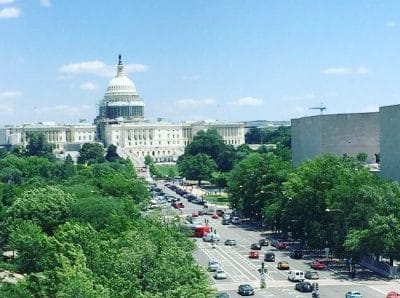*This article has been updated to reflect that President Trump has signed the bill into law.
Shortly after Congress passed the Coronavirus Aid, Relief, and Economic Security (CARES) Act, President Trump signed the legislation that is aimed at helping the economy rebound amid the coronavirus pandemic’s devastating impact.

A day after the $2 trillion economic stimulus package – the largest in U.S. history – was unanimously passed by the Senate, the House followed suit by approving the legislation which includes nearly $350 billion for small businesses, $500 billion in loan funding for major industries, expanded unemployment benefits, a one-item $1,200 payment to most Americans, and $150 billion in healthcare funding.
This was the third bill in a series of response bills related to the coronavirus outbreak. The first of the relief packages provided $7.76 billion to the U.S. Department of Health and Human Services, and the second expanded the availability of testing as well as expanded unemployment, food assistance, and paid leave benefits.
During today’s House vote, the bill received the support of Mississippi’s delegation.
“As the number of cases around the US grow, so does the economic concern of many Mississippians. This bill will get much-needed assistance directly into the hands of Mississippians so they can continue meeting their basic needs while remaining at home and slowing the spread. The legislation also invests in our health care workers, including our rural providers, and contains strong provisions that provide significant relief to small businesses in south Mississippi. While the legislation is not perfect, I am proud to see this relief bill move forward to President Trump’s desk.” – Rep. Steven Palazzo (MS-4)
“I commend the passage of the CARES Act, which will help our nation’s workers and families, including the more than 200,000 Department of Homeland Security employees on the frontlines of this national emergency, during this unprecedented crisis. As the number of coronavirus cases in our country approaches 100,000, it is critical that Congress continues to provide vital support to our communities, address the shortfalls in the Administration’s response, and provide the stability and support our nation needs. As this bill is enacted, I will continue to hold this Administration accountable and ensure that our ongoing response efforts equitably serve the needs of all in the country who are impacted by this global pandemic.” – Rep. Bennie Thompson (MS-2)
Congressmen Trent Kelly (MS-1) and Michael Guest (MS-3) also supported the bill.
Following yesterday’s vote, Senators Roger Wicker & Cindy Hyde-Smith each voiced their support as well.
A detailed breakdown of the bill was provided by Rep. Palazzo.
Tax Provisions
-includes a one-time tax rebate check
-$1,200 per individual, $2,400 per couple, $500 per eligible child
-The amount listed above is not reduced for lower-income Americans
-The amount listed above does decrease for higher-income earners, starting at $75,000 for individuals, $112,500 for head of household, and $150,000 for married couples
-Phases out completely at $99,000 for individuals and $198,000 for married couples
-Expands unemployment insurance to cover gig workers and self-employed as well as non-profit employees
Small Business Provisions
-Creates new SBA-backed loan program to help small businesses pay for expenses
-Loans taken by small businesses to keep employees on payroll may be forgiven
-Creates “paycheck protection” program that incentivizes small businesses to keep employees on payroll
-The “Paycheck Protection Program” will provide 8 weeks of cash-flow assistance, rent, and utilities at 100% up to 2.5x average monthly payroll
-501 (c)(3)s will also be eligible for this program
-Offers extensive debt relief
-Requires Small Business Administration to enact these programs no later than 15 days after the bill is signed into law
Health Provisions
-Gets more resources into the hands of health care providers
-Expands access to care for patients
-Supports public health response by prioritizing treatment for COVID-19 patients
-Increases Medicare reimbursement rate to assist providers caring for our most vulnerable population
-Provides $16 billion for the Strategic National Stockpile to procure personal protective equipment, ventilators, and other medical supplies for federal and state response
-Allows the FDA to quickly approve the use of new medication and treatments
-Facilitates the use of new and innovative telemedicine technology to protect and contain the spread of COVID-19.
-Includes $140 billion to support the US health system
-Provides 13 weeks of unemployment benefits above what is available under state law
-Adds $600 to weekly compensation benefits that states provide for up to 4 months
-Provides 39 weeks of unemployment benefits under state law, including self-employed, independent contractors, those with limited work history, those who are sick with or caring for a family member with coronavirus, those caring for child or other individual whose school or place of care is closed.
-Reimburses states who have, or want to develop, unemployment benefits for those who are working but on reduced hours
-Allows states to reimburse nonprofit, government agency, and tribes for half the costs of unemployment benefits they provide to their employees
-Reimburses states for the cost of providing unemployment benefits immediately when someone becomes unemployed instead of waiting for one week
Student Loan Provisions
-Defers payments, including principal and interest, on student loans for six months
-Suspends involuntary collections of loans from wage garnishment, reduction of tax refunds or social security benefits
-For those working to earn Public Service Loan Forgiveness, months in which payments are deferred will be counted as if they were paid
-Allows colleges to pay Work Study participants even if they can’t complete work requirements because of the COVID-19
-If a student has to drop out of school because of the virus outbreak, they are still eligible for a Pell Grant and federal student loans in the future. Moreover, the semester in which they dropped out will not count toward the number of semesters they’re eligible to receive aid







